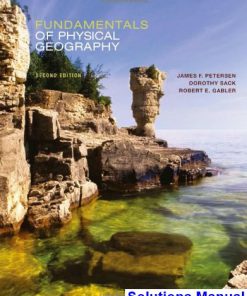Physical Geography 11th Edition Petersen Test Bank
You may also like
This is completed downloadable of Physical Geography 11th Edition Petersen Test Bank

Product Details:
- ISBN-10 : 1305652649
- ISBN-13 : 978-1305652644
- Author:
PHYSICAL GEOGRAPHY, Eleventh Edition, uses the combined expertise of three accomplished and respected geographers to show not only what constitutes physical geography but also the interrelationships between people and Earth’s natural environment. The well-written text and excellent illustrations emphasize three essential themes to demonstrate the major roles of the discipline — Geography as Physical Science, Geography as Spatial Science, and Geography as Environmental Science. With a strong focus on processes and the interrelationships among Earth’s systems, this text guides you to an understanding and appreciation of how the various natural systems function and of how humans are an integral component of physical geography. Historically, this was the first Physical Geography textbook to take an environmental sustainability approach, and the authors continue to address the theme of human interactions with the environment.
Table of Content:
- Ch 1: Physical Geography: Earth Environments and Systems
- The Study of Geography
- Physical Geography
- Geographic Tools and Technology
- Major Perspectives in Physical Geography
- Using Models and Systems
- Physical Geography and You
- Chapter 1 Activities
- Ch 2: Representations of Earth
- Maps and Location on Earth
- The Geographic Grid
- Maps and Map Projections
- Modern Mapmaking
- Remote Sensing of the Environment
- Multispectral Remote Sensing
- Chapter 2 Activities
- Map Interpretation: Topographic Maps
- Ch 3: Solar Energy and Earth-Sun Relationships
- The Solar System and Beyond
- The Earth-Sun System
- Insolation, Sun Angle, and Duration
- Chapter 3 Activities
- Ch 4: The Atmosphere, Temperature, and Earth’s Energy Budget
- The Nature of Our Atmosphere
- Energy Transfer Processes
- Earth’s Energy Budget
- Air Temperature
- Weather and Climate
- Complexity of Earth’s Energy Systems
- Chapter 4 Activities
- Ch 5: Atmospheric Pressure, Winds, and Circulation Patterns
- Atmospheric Pressure
- Cells of High and Low Pressure
- Wind
- Global Pressure and Wind Systems
- Global Wind Systems
- Upper Air Winds and Jet Streams
- Regional and Local Wind Systems
- Ocean-Atmosphere Interactions
- Chapter 5 Activities
- Ch 6: Humidity, Condensation, and Precipitation
- The Hydrologic Cycle
- Water in the Atmosphere
- Sources of Atmospheric Moisture
- Condensation, Fog, and Clouds
- Adiabatic Heating and Cooling
- Precipitation Processes
- Distribution of Precipitation
- Precipitation Variability
- Chapter 6 Activities
- Ch 7: Air Masses and Weather Systems
- Air Masses
- Fronts
- Atmospheric Disturbances
- Chapter 7 Activities
- Map Interpretation: Weather Maps
- Ch 8: Global Climates and Climate Change
- Classifying Climates
- Climate Change
- Recent Climate Change
- Chapter 8 Activities
- Graph Interpretation: The Koppen Climate Classification System
- Ch 9: Low-Latitude and Arid Climate Regions
- Humid Tropical Climate Regions
- Arid Climate Regions
- Chapter 9 Activities
- Ch 10: Midlatitude, Polar, and Highland Climate Regions
- Mesothermal Climate Regions
- Microthermal Climate Regions
- Polar Climate Regions
- Highland Climate Regions
- Chapter 10 Activities
- Ch 11: Biogeography
- Ecosystems
- Environmental Controls
- Classification of Terrestrial Ecosystems
- Forest Biomes
- Grassland Biomes
- Desert Environments
- Arctic and Alpine Tundra
- Marine Ecosystems
- The Resilience of Life Forms
- Chapter 11 Activities
- Ch 12: Soils and Soil Development
- Major Soil Components
- Soil Characteristics
- Development of Soil Horizons
- Factors Affecting Soil Formation
- Soil-Forming Regimes
- Soil Classification
- Soil as a Critical Natural Resource
- Chapter 12 Activities
- Ch 13: Earth Materials and Plate Tectonics
- Earth’s Planetary Structure
- Earth Materials
- Plate Tectonics
- Geologic Time and Paleogeography
- Chapter 13 Activities
- Ch 14: Tectonism and Volcanism
- Introduction to Geomorphology
- Tectonics Forces, Structures, and Landforms
- Earthquakes
- Igneous Processes and Landforms
- Distribution of Endogenic Processes
- Chapter 14 Activities
- Map Interpretation: Volcanic Landforms
- Ch 15: Weathering and Mass Wasting
- Nature of Exogenic Processes
- Weathering
- Variability in Weathering
- Mass Wasting
- Weathering, Mass Wasting, and the Landscape
- Chapter 15 Activities
- Ch 16: Subsurface Water and Karst
- Nature of Underground Water
- Springs
- Using Groundwater Resources
- Landform Development by Solution
- Chapter 16 Activities
- Map Interpretation: Karst Topography
- Ch 17: Fluvial Processes and Landforms
- Surface Runoff
- The Stream System
- Flow Properties
- Fluvial Processes
- Channel Patterns
- Fluvial Landscapes
- Rivers, Lakes, and People
- Quantitative Fluvial Geomorphology
- Chapter 17 Activities
- Map Interpretation: Fluvial Landforms
- Ch 18: Arid Region and Eolian Landforms
- Surface Runoff in the Desert
- Water as a Geomorphic Agent in Arid Lands
- Wind as a Geomorphic Agent
- Sand Dunes
- Loess Deposits
- Landscape Development in Deserts
- Chapter 18 Activities
- Map Interpretation: Desert Basin Landforms
- Map Interpretation: Eolian Landforms
- Ch 19: Glacial Systems and Landforms
- Glacier Formation and the Hydrologic Cycle
- Types of Glaciers
- How Do Glaciers Flow?
- Glaciers as Geomorphic Agents
- Alpine Glaciers
- Continental Glaciers
- Glacial Lakes
- Periglacial Landscapes
- Chapter 19 Activities
- Map Interpretation: Alpine Glaciation
- Map Interpretation: Continental Glaciation
- Ch 20: Coastal Processes and Landforms
- The Coastal Zone
- Origin and Nature of Waves
- Coastal Geomorphic Processes
- Types of Coasts
- Islands and Coral Reefs
- Change over Time
- Chapter 20 Activities
- Map Interpretation: Active-Margin Coastlines
- Map Interpretation: Passive-Margin Coastlines
- Appendix A: International System of Units (SI), Abbreviations, and Conversions
- Appendix B: Topographic Maps
- Appendix C: Understanding and Recognizing Some Common Rocks
- Glossary
- Index
People Also Search:
physical geography petersen
physical geography 11th edition petersen
physical geography 11th edition
physical geography 11th edition download scribd
physical geography 11th edition testbank download pdf












